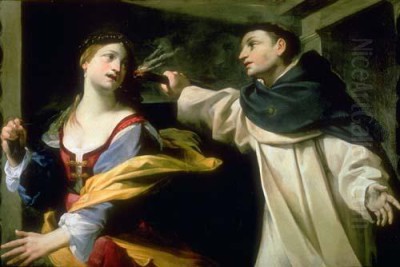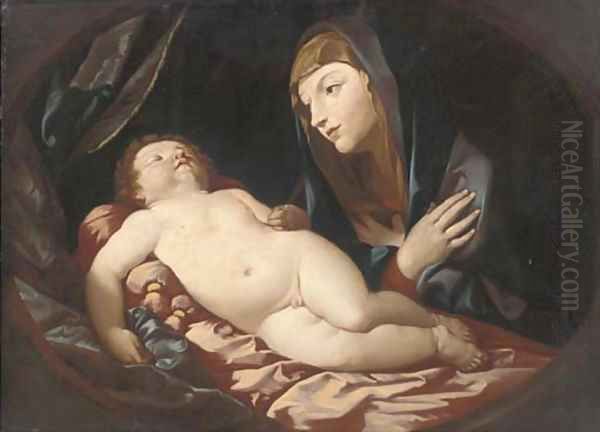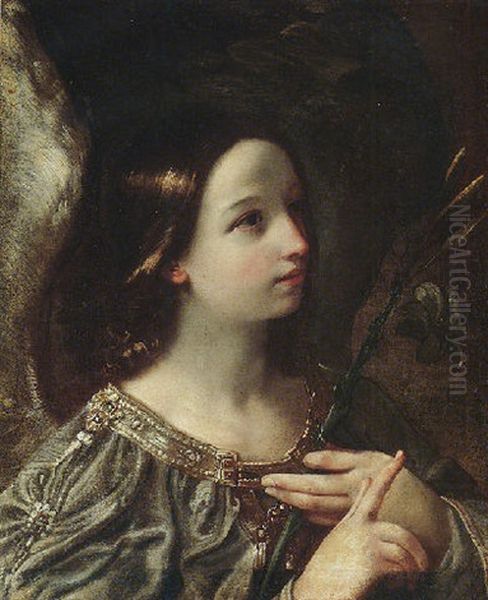
Francesco Giovanni Gessi, a prominent figure in the Bolognese School of painting, carved out a significant, albeit sometimes complex, career during the vibrant Italian Baroque period. Born in Bologna in 1588, Gessi's artistic journey was inextricably linked with that of his celebrated master, Guido Reni. While he achieved considerable recognition for his skill and adherence to Reni's elegant style, Gessi also developed his own artistic nuances, leaving behind a body of work that continues to attract scholarly attention. His life, marked by both artistic triumphs and personal rivalries, offers a fascinating glimpse into the competitive and dynamic art world of 17th-century Italy.
Early Life and Apprenticeship in Bologna
Bologna, at the turn of the 17th century, was a crucible of artistic innovation. The legacy of the Carracci family – Ludovico, Annibale, and Agostino Carracci – and their Accademia degli Incamminati had fundamentally reshaped painting, emphasizing a return to naturalism combined with classical ideals. It was into this fertile artistic environment that Francesco Gessi was born. His early inclination towards art led him to the preeminent workshop in the city, that of Guido Reni (1575-1642).
Reni, himself a product of the Carracci influence, had by this time established himself as a leading master, renowned for his graceful figures, harmonious compositions, and delicate, often silvery, palette. Gessi became one of Reni's most notable pupils, absorbing his master's style with such proficiency that he earned the moniker "il secondo Reni" (the second Reni) or, as some sources suggest, was seen as a kind of artistic heir. This close stylistic affinity, while a testament to Gessi's talent, would also lead to his works occasionally being mistaken for those of Reni himself.

In Reni's studio, Gessi would have participated in the collaborative environment typical of the era. Apprentices learned by copying the master's works, assisting on larger commissions, and gradually undertaking independent assignments under supervision. This training instilled in him a strong foundation in drawing, composition, and the refined execution that characterized Reni's output. Other notable painters who passed through Reni's studio around this period included Francesco Albani, Simone Cantarini ("Il Pesarese"), and Giovanni Andrea Sirani, creating an atmosphere of both learning and nascent competition.
Artistic Style and Development
Gessi's early works naturally bear the strong imprint of Guido Reni. He demonstrated a remarkable ability to emulate Reni's classical elegance, the gentle contrapposto of his figures, and the soft, idealized rendering of flesh and drapery. His subject matter, like Reni's, frequently drew from biblical narratives and classical mythology, themes that were highly sought after by patrons of the Church and private collectors alike. The prevailing Baroque taste for drama and emotional intensity was often tempered in Reni's school by a pursuit of grace and beauty.
However, as Gessi matured as an artist, his style began to exhibit subtle shifts. Art historians note that from the 1630s onwards, his palette started to incorporate brighter and more vibrant colors. This evolution has been attributed by some to the influence of Tuscan painters, suggesting either travel or exposure to works from that region. This move towards a more luminous chromatic range distinguished some of his later works from the more subdued, pearlescent tones often favored by Reni in certain phases of his career.
Despite these developments, Gessi remained largely faithful to the fundamental principles of the Bolognese school, emphasizing clear narrative, balanced composition, and a certain decorum in the depiction of religious and mythological scenes. His technical skill was widely acknowledged, and he was known for his ability to work with considerable speed and precision, a valuable asset in securing and completing commissions.
Major Works and Commissions
Francesco Gessi's oeuvre includes a significant number of altarpieces and devotional paintings, many of which were destined for churches in Bologna and the surrounding regions. One of his most celebrated early commissions was the altarpiece for the Church of San Salvatore in Bologna, depicting Christ with the Children (sometimes referred to as Christ Surrounded by a Halo of Light or Salvator Mundi), completed around 1620. This work would have showcased his mastery of Reni's style, likely featuring a serene Christ figure, gracefully rendered children, and a harmonious, divinely lit composition.

Another significant project involved collaboration. Gessi worked alongside fellow Reni pupils, Giovanni Giacomo Sementi and Bartolomeo Marescotti, on the decoration of the Cathedral of the Assumption in Ravenna. Their involvement, which began around 1614 and concluded by 1621, included frescoes such as the scene of Moses Gathering the Manna above the high altar. Such collaborative projects were common for large-scale decorative schemes, allowing for the efficient completion of extensive works.
His painting Madonna and Child, dated to 1624, is another example of his engagement with popular devotional themes, likely characterized by tender emotion and refined execution. Other notable works attributed to Gessi include The Finding of Moses (c. 1612-1615), a subject that allowed for rich narrative detail and exotic settings, and a Resurrection of Christ, believed to be located in the Certosa di Bologna, a theme demanding dynamic composition and dramatic lighting.
Further attributions include The Death of Saint Joseph, a poignant subject often depicted with intimate emotion, which was recorded as being in a private collection and also mentioned in connection with the Church of San Michele in Bologna. A Christ in the Garden was featured in a 2021 auction catalogue, indicating the continued presence of his works in the art market. A drawing, Profile Head of an Old Man, housed in the public library of Monte San Giustino, demonstrates his skill in draughtsmanship, a foundational element of Bolognese artistic practice.
The Complex Relationship with Guido Reni
The relationship between Francesco Gessi and his master, Guido Reni, was multifaceted and evolved over time. Initially, Gessi was a favored and highly proficient pupil, benefiting greatly from Reni's instruction and patronage. Reni reportedly entrusted Gessi with significant responsibilities within the workshop, a sign of his confidence in the younger artist's abilities.
However, this close association eventually became strained. Sources suggest that Gessi's own ambitions, coupled perhaps with a degree of jealousy towards Reni's immense success and the master's favor towards other pupils, led to friction. There are accounts of Gessi making excessive demands or displaying a competitive spirit that soured the relationship. This dynamic was not uncommon in the hierarchical and often fiercely competitive art world of the 17th century, where a master's leading pupil might naturally aspire to independent recognition and even rivalry.

The artistic bond, however, remained strong in terms of style. Gessi's deep understanding and assimilation of Reni's manner meant that his works often closely mirrored those of his master, sometimes to his detriment in terms of establishing a wholly independent artistic identity in the eyes of later critics. Nevertheless, this very closeness also ensured a steady stream of commissions from patrons who admired Reni's style. The tension between emulation and individual expression is a recurring theme in Gessi's career.
Collaborations, Competitions, and Contemporaries
The art scene in Bologna was a close-knit community where artists frequently collaborated on large projects but also competed vigorously for commissions and prestige. Gessi was no exception. His work in Ravenna with Sementi and Marescotti is a clear example of such collaboration. He would have also interacted with other artists from Reni's circle, including Giovanni Andrea Sirani and, by extension, Sirani's highly talented daughter, Elisabetta Sirani, who became a celebrated painter in her own right.
Competition was an ever-present factor. Domenichino (Domenico Zampieri), another highly successful Bolognese painter who, like Reni, had trained with the Carracci, was a significant figure. An anecdote describes Domenichino "poaching" a talented student, Giovanni Battista Ruggieri, from Reni's studio, indicative of the rivalries not just between individual artists but also between their workshops or "schools" of followers. Gessi would have found himself navigating this competitive landscape, vying for patronage alongside other established and emerging talents.
Beyond Reni's immediate circle, the Bolognese art world included figures like Guercino (Giovanni Francesco Barbieri), whose style, while also Baroque, offered a different sensibility, often characterized by more robust naturalism and dramatic chiaroscuro. Alessandro Tiarini and Lionello Spada were other notable Bolognese contemporaries, each contributing to the city's rich artistic tapestry. Further afield, artists like Giovanni Lanfranco, who also had Carracci training, were making their mark in Rome, and their innovations would have resonated back in Bologna.
Gessi as a Teacher and His Influence
Like many established masters, Francesco Gessi also took on pupils, contributing to the continuation of the Bolognese artistic tradition. Among those recorded as his students are Giacomo Castellini, Francesco Coreggio (possibly a misspelling of Correggio, though unlikely to be the famous Renaissance master), and Giulio Tivo. Through his teaching, Gessi would have disseminated the principles he had learned from Reni, further entrenching that particular stylistic lineage within Bolognese art.
His influence, however, was largely filtered through the lens of Reni's dominant style. While Gessi was a respected and successful painter, his artistic persona remained closely tied to that of his master. His primary impact lay in his skilled execution and propagation of Reni's aesthetic, which appealed to a wide range of patrons seeking elegance, grace, and refined religious sentiment in art. His works can be seen as an important component of the "Reni school," which collectively shaped Bolognese painting for a significant portion of the 17th century. Later Bolognese artists, such as Carlo Cignani, would continue to evolve the classical-Baroque tradition.
Later Career, Death, and Discrepancies
Details about Gessi's later career suggest a continued practice, with his style evolving to incorporate a brighter palette, as previously mentioned. He remained active primarily in Bologna and the Emilia-Romagna region.
There is some discrepancy in historical records regarding the exact year of his death. Many sources cite his death in Bologna in 1649. However, other evidence has been presented suggesting he may have died as early as 1647. Such minor inconsistencies are not unusual in historical records from this period, often relying on parish records or biographical accounts written sometime after the events. One anecdotal claim, mentioned in the provided research, suggests an early death at age 34 due to refusing medical advice; however, if born in 1588, this would place his death around 1622, which contradicts the more substantial evidence of his activity and commissions well into the 1620s, 1630s, and 1640s. The 1649 date, or slightly earlier in 1647, remains the most widely accepted timeframe for his passing.
Legacy and Modern Reappraisal
For a period, Francesco Gessi's artistic identity was somewhat subsumed by that of Guido Reni. The very skill with which he emulated his master meant that attributions could be challenging, and his works were sometimes undervalued as mere imitations. However, modern art historical scholarship has sought to re-evaluate Gessi's contributions more distinctly.
Exhibitions and scholarly publications have played a crucial role in this reappraisal. For instance, the inclusion of his work The Finding of Moses in collections like that of the National Gallery of Art in Washington, D.C., brings his art to a wider international audience. Publications such as Lives of Domenichino and Francesco Gessi (likely referring to biographical accounts by figures like Giovanni Pietro Bellori or Carlo Cesare Malvasia, who wrote extensively on Bolognese artists) and more recent studies like Reframing Seventeenth-Century Bolognese Art: Archival Discoveries shed new light on his career, commissions, and specific works. The appearance of his paintings in auction catalogues, such as the Christ in the Garden in the WANNENES catalogue, and the inclusion of his drawings in collections like the Alessandro Maggiori Collection (highlighted in Timeless Renaissance), further attest to ongoing interest and research.
These efforts help to distinguish Gessi's hand, appreciate his individual artistic choices – such as his later, brighter palette – and understand his role within the complex network of the Bolognese school. He emerges as a highly skilled and productive artist who, while deeply indebted to Guido Reni, nevertheless forged a successful career and contributed meaningfully to the artistic landscape of his time.
Conclusion
Francesco Giovanni Gessi stands as a significant representative of the Bolognese Baroque, an artist whose career was shaped by the towering influence of Guido Reni yet marked by his own discernible talents and artistic evolution. His proficiency in capturing the grace and elegance of Reni's style ensured his success, while his later explorations with color suggest an artist seeking his own subtle modulations within the established framework. His numerous altarpieces and religious paintings adorned churches and collections, fulfilling the devotional and aesthetic demands of his era.
While the shadow of Reni has at times obscured a full appreciation of Gessi's individual merits, ongoing scholarship continues to illuminate his specific contributions. His life and work offer valuable insights into the dynamics of the master-pupil relationship, the collaborative and competitive nature of 17th-century art production, and the enduring legacy of the Bolognese school. Francesco Gessi remains an important figure for understanding the richness and complexity of Italian Baroque art.